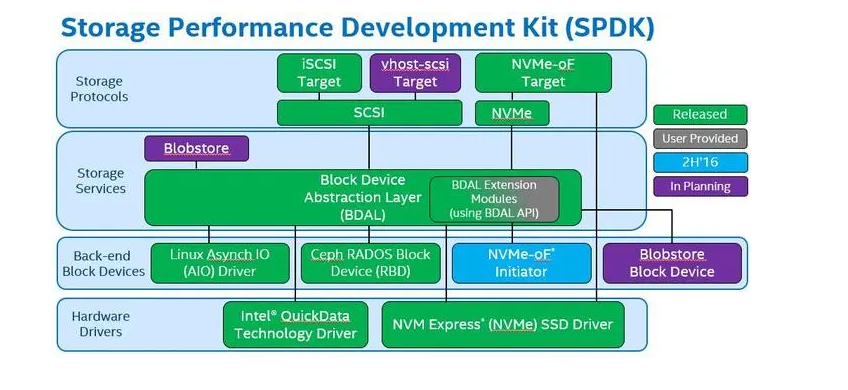以下是一个使用SPDK进行I/O操作测量的代码案例:
#include <stdio.h>
#include <stdlib.h>
#include <string.h>
#include <rte_config.h>
#include <rte_eal.h>
#include <rte_mempool.h>
#include "spdk/stdinc.h"
#include "spdk/nvme.h"
#define NUM_IO_REQUESTS 32
#define BLOCK_SIZE 4096
struct io_request {
struct spdk_nvme_qpair *qpair;
void *buf;
};
static void submit_io_requests(struct spdk_nvme_qpair *qpair, struct io_request *io_reqs,
uint64_t lba_start, uint32_t lba_count)
{
int i;
for (i = 0; i < NUM_IO_REQUESTS; ++i) {
spdk_nvme_ns_cmd_read(qpair, io_reqs[i].buf, lba_start + i,
BLOCK_SIZE / sizeof(uint64_t), NULL, 0, 0);
}
while (spdk_nvme_qpair_process_completions(qpair, NUM_IO_REQUESTS) != NUM_IO_REQUESTS);
for (i = 0; i < NUM_IO_REQUESTS; ++i) {
spdk_nvme_ns_cmd_write(qpair, io_reqs[i].buf, lba_start + i,
BLOCK_SIZE / sizeof(uint64_t), NULL, 0, 0);
}
while (spdk_nvme_qpair_process_completions(qpair, NUM_IO_REQUESTS) != NUM_IO_REQUESTS);
}
int main(int argc, char **argv)
{
int ret;
uint32_t nsid;
struct spdk_env_opts opts;
struct spdk_env_params params;
struct spdk_nvme_ctrlr *ctrlr;
struct spdk_nvme_ns *ns;
struct spdk_nvme_qpair *qpair;
struct rte_mempool *buf_pool;
uint64_t lba_count = 1024*1024*1024/BLOCK_SIZE; //1GB
uint64_t io_size = NUM_IO_REQUESTS*BLOCK_SIZE;
struct io_request io_reqs[NUM_IO_REQUESTS];
memset(&opts, 0, sizeof(opts));
opts.name = "spdk_io_test";
spdk_env_init(&opts);
memset(¶ms, 0, sizeof(params));
params.mem_size = 2048;
ret = spdk_vtophys_init(¶ms);
if (ret) {
fprintf(stderr, "Unable to initialize vtophys\n");
return ret;
}
ret = spdk_nvme_probe(NULL, NULL, attach_cb, NULL);
if (ret) {
fprintf(stderr, "Unable to probe for NVMe devices\n");
return ret;
}
ctrlr = spdk_nvme_connect("nvme0", NULL);
if (!ctrlr) {
fprintf(stderr, "Unable to connect to NVMe controller\n");
return -1;
}
nsid = spdk_nvme_ctrlr_get_first_active_ns(ctrlr);
ns = spdk_nvme_ctrlr_get_ns(ctrlr, nsid);
buf_pool = rte_pktmbuf_pool_create("buf_pool", 8192,
512 + RTE_PKTMBUF_HEADROOM,
32,
BLOCK_SIZE - RTE_PKTMBUF_HEADROOM,
rte_socket_id());
if (!buf_pool) {
fprintf(stderr, "Unable to create mbuf pool\n");
return -1;
}
qpair = spdk_nvme_ctrlr_alloc_io_qpair(ctrlr, NULL, 0);
if (!qpair) {
fprintf(stderr, "Unable to allocate IO queue pair\n");
return -1;
}
int i;
for (i = 0; i < NUM_IO_REQUESTS; ++i) {
struct rte_mbuf *buf = rte_pktmbuf_alloc(buf_pool);
io_reqs[i].qpair = qpair;
io_reqs[i].buf = rte_pktmbuf_mtod_offset(buf, void *, RTE_PKTMBUF_HEADROOM);
}
uint64_t lba_start = 0;
while (lba_start < lba_count) {
submit_io_requests(qpair, io_reqs, lba_start, NUM_IO_REQUESTS);
lba_start += NUM_IO_REQUESTS;
printf("Processed %lu of %lu LBAs\n", lba_start,
lba_count);
}
spdk_nvme_ctrlr_free_io_qpair(qpair);
spdk_nvme_detach(ctrlr);
return 0;
}
这个代码案例使用SPDK库进行I/O操作测量。它首先初始化SPDK环境和参数,然后探测NVMe设备并连接到控制器。之后,它分配一个I/O队列对,并创建一些用于I/O请求的缓冲区。接下来,它循环执行读写操作,每次处理NUM_IO_REQUESTS个逻辑块地址(LBA),直到处理完整个磁盘的所有LBA。最后,它释放队列对和控制器,并返回0表示成功。
该代码案例可以帮助开发人员了解如何使用SPDK库进行I/O操作测量,以及如何处理NVMe设备。





















